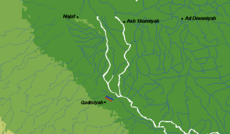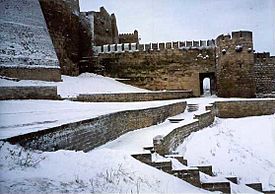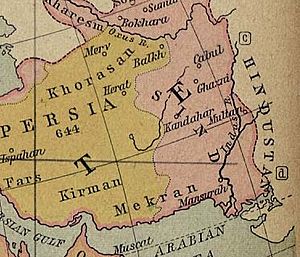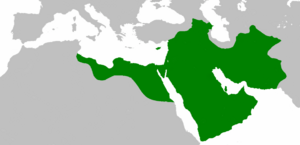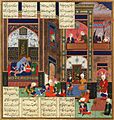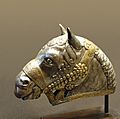Muslim conquest of Persia facts for kids
Quick facts for kids Muslim conquest of Persia |
|||||||||
|---|---|---|---|---|---|---|---|---|---|
| Part of the early Muslim conquests | |||||||||
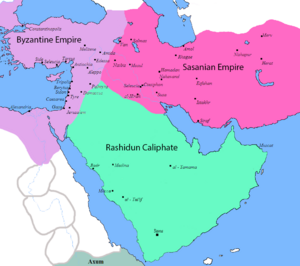 Map of Iran (Persia) and its surrounding regions on the eve of the Muslim invasions |
|||||||||
|
|||||||||
| Belligerents | |||||||||
Caucasian Albania (633–636) Arab Christians (633–637) Kanārangīyāns (633–651) House of Ispahbudhan (633–651) House of Mihran (633–651) House of Karen (633–654) Dabuyids (642–651) Hephthalites (651–654) Supported by: |
|||||||||
| Commanders and leaders | |||||||||
|
See list
Abu Bakr
(Until 634) Umar ibn al-Khattab (Assassinated) Uthman ibn Affan Khalid ibn al-Walid (633–634) al-Muthanna ibn Haritha (WIA) Abu Ubayd † Sa`d ibn Abi Waqqas Zuhra ibn Al-Hawiyya Hashim ibn Utbah al-Jarud ibn al-Mu'alla † 'Ubayd Allah ibn Ma'mar † Qa’qa ibn Amr Tulayha † Amru bin Ma'adi Yakrib † Abu Musa Ashaari Ammar ibn Yasir Nouman ibn Muqarrin † Al-Ala al-Hadhrami Hudhayfah ibn al-Yaman Mugheera ibn Shuba Usman ibn Abi al-Aas Al-Qaqa ibn Amr al-Tamimi Asim ibn 'Amr al-Tamimi al-Sawwar ibn Hammam † Iyad ibn Ghanm Asim ibn Amr Al-Hakam † Jabr † Khalid ibn Urfuta Ahnaf ibn Qais Abdullah ibn Aamir Khawlah bint Azwar Bukayr ibn Abdallah Kanadbak Busbuhra (Briefly) 'Amr ibn al-'As Farrukhzad |
See list
Rostam Farrokhzad † Mahbudhan Huzail ibn Imran Hormozd Jadhuyih Bahman Jadhuyih † Anoshagan † Andarzaghar Piruz Khosrow † Jaban (POW) Mihran Bahram-i Chubin Hormuzan (POW) Mardanshah † Bahram Isfandiyar Jalinus † Mihran Razi † Nakhiragan Azadbeh Farrukhzad Siyavakhsh † Shahriyar bin Kanara † Busbuhra (DOW) Shahriyar of Derbent † Farrukbandadh † Mihran-i Hamadani † Shahrvaraz Jadhuyih † Karin † Mushegh III † Varaztirots † Muta † Narsi Tiruyih Kanadbak Shirzad Mardanshah of Damavand Javanshir Burzin Shah Mahoe Suri Shahriyar Siyah al-Uswari Shiruya al-Uswari Aparviz Shahrag † Faylakan † Yazdanfar Qubaz † Ruzbih † Zarmahr † Jushnasmah † Mihran bin Badhan † Hormozd † Mahak Fadhusfan (Until 641) |
||||||||
The Muslim conquest of Persia, also called the Arab conquest of Iran, happened between 632 and 654. It was carried out by the Rashidun Caliphate and led to the end of the Sasanian Empire. This also caused the Zoroastrian religion to slowly decline.
The rise of the Muslims in Arabia happened when Persia was very weak. The Sasanian Empire, once a major world power, had used up its resources. This was due to many years of fighting against the Byzantine Empire. The Sasanian government became unstable after King Khosrow II was killed in 628. Ten new rulers took the throne in just four years. After a civil war (628–632), the empire was no longer united.
Arab Muslims first attacked Sasanian land in 633. Khalid ibn al-Walid invaded Mesopotamia (modern-day Iraq), which was the heart of the Sasanian state. When Khalid moved to fight the Byzantines, the Muslims lost their gains. The second Muslim invasion began in 636. A key victory at the Battle of al-Qadisiyyah ended Sasanian control west of modern-day Iran.
For the next six years, the Zagros Mountains formed a natural border. In 642, Umar ibn al-Khattab, the Muslim Caliph, ordered a full invasion of Persia. This led to the complete conquest of the Sasanian Empire by 651. Umar, directing from Medina, managed this quick conquest with well-planned attacks. This made him known as a great military and political leader. In 644, before Persia was fully taken, Umar was assassinated. He was killed by Abu Lu'lu'a Firuz, a Persian craftsman.
By 651, most cities in Iran were under Arab Muslim control. Some areas, like the Caspian provinces, were exceptions. Many places fought back against the invaders. They sometimes killed Arab governors or attacked their soldiers. But Arab military help eventually stopped these rebellions. This brought complete Islamic control. The Islamization of Iran happened slowly over centuries. Some Iranians never converted. There were also cases of Zoroastrian scriptures being burned and priests being killed. This happened especially in areas that resisted violently. Over time, Persians started to keep their Persian language and Iranian culture. Islam became the main religion in Iran by the late Middle Ages.
Contents
Sasanian Empire Before the Conquest
For centuries, the Euphrates River was the border between the Roman (later Byzantine) and Parthian (later Sasanian) empires. This border was always being fought over. Most battles happened in the northern hills. The large Arabian or Syrian Desert separated the empires in the south. The only danger from the south was occasional raids by nomadic Arab tribes.
Both empires made friends with small Arab kingdoms. These kingdoms acted as buffer states. They protected Byzantium and Persia from Bedouin attacks. The Byzantines had the Ghassanids, and the Persians had the Lakhmids. These two groups often fought each other. This kept them busy and didn't affect the bigger empires much. But in the 6th and 7th centuries, this balance of power changed.
The long conflict with the Byzantines made the Sasanian Empire weak. It used up many of its resources. This made it an easy target for the Muslims.
Social Problems
Sasanian society had four main groups: priests, warriors, secretaries, and commoners. The commoners were the largest group. They paid most of the taxes and were the poorest.
During Khosrau II's conquests, taxes went up a lot. Most people could not pay them. Years of wars had ruined trade routes and industries. These were the main ways people earned money. The Sasanian government was not set up to handle such a large empire and economy. Rulers changed quickly, and local landowners (dehqan) gained more power. Over 14 years, 12 different kings and queens ruled. This made the Sasanian Empire much weaker. Power shifted to its generals. Even when a strong king appeared, the Sassanids never fully recovered.
Key Events
Arab Client States Revolt (602)
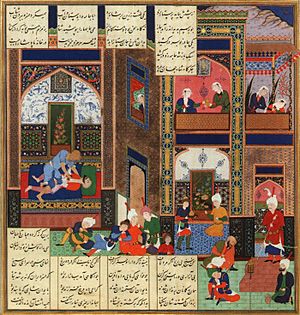
The Arab Ghassanids, who were allies of the Byzantines, became Monophysite Christians. This was seen as a heresy by the main Byzantine Church. The Byzantines tried to stop this, which angered the Ghassanids. This led to rebellions on their desert borders.
The Lakhmids, allies of the Persians, also rebelled against King Khosrau II. Nu'man III, the first Christian Lakhmid king, was removed and killed by Khusrau II in 602. He had tried to break free from Persian control. After Khosrau's death in 628, the Persian Empire broke apart. The Lakhmids became almost independent. Many believe that taking over the Lakhmid kingdom was a big reason for the Sasanian Empire's fall. The Lakhmids later helped the Muslims by spying for them. This happened after they were defeated in the Battle of Hira by Khalid ibn al-Walid.
Byzantine–Sasanian War (602–628)
The Persian ruler Khosrau II first put down a rebellion in his own empire. Then he focused on his old enemies, the Byzantines. This led to the Byzantine-Sassanid War of 602–628. For a few years, he was very successful. From 612 to 622, he expanded Persian borders greatly. He captured lands as far as Egypt and Palestine.
The Byzantines fought back in 622 under Heraclius. Khosrau was defeated at the Battle of Nineveh in 627. The Byzantines took back all of Syria and went deep into Persian lands. In 629, Khosrau's general Shahrbaraz made peace. The border between the two empires returned to where it was in 602.
Plague of Sheroe
The Plague of Sheroe (627–628) was one of several diseases that hit Iran. It came from Sasanian armies returning from campaigns. This plague weakened the Sasanian Empire even more.
Khosrau II's Execution
Khosrau II was killed in 628. After his death, many people wanted to be king. From 628 to 632, there were ten different kings and queens of Persia. The last one, Yazdegerd III, was Khosrau II's grandson. He was said to be only 8 years old.
Muhammad's Letter
After a peace treaty in 628, Islamic stories say that Muhammad sent letters to many rulers. He asked them to become Muslim. One letter was supposedly sent to Khosrau II of Persia.
Muslim histories say that Muhammad sent his officer, Abdullah Huzafah Sahmi Qarashi, to carry this letter. It invited Khosrau II to become Muslim.
The letter said:
In the name of God, the Beneficent, the Merciful.
From Muhammad, the Messenger of God, to the great Kisra of Persia. Peace be upon him, who seeks truth and expresses belief in God and in His Prophet and testifies that there are no gods but one God whom has no partners, and who believes that Muhammad is His servant and Prophet. Under the Command of God, I invite you to Him. He has sent me for the guidance of all people so that I may warn them all of His wrath and may present the unbelievers with an ultimatum. Embrace Islam so that you may remain safe. And if you refuse to accept Islam, you will be responsible for the sins of the Magi.
There are different stories about how Khosrau II reacted to this letter.
Military Weakness
Years of war with the Byzantines and Khazar invasions had tired out the Persian army. No strong ruler followed Khosrau II. This caused chaos and problems in the government. All these things weakened the Persian army. Yazdegerd III was only 8 when he became king. He didn't try to rebuild the army.
The Sasanian Empire was not very centralized. It was more like a "confederation" with the Parthians. The Parthians had a lot of independence. After the last Sasanian-Byzantine war, the Parthians wanted to leave this confederation. So, the Sasanians were not ready to fight the Muslim armies. Powerful Parthian families in the north and east made peace with the Arabs. They refused to fight alongside the Sasanians.
When Arab groups first raided Sasanian land, Yazdegerd III didn't see them as a big threat. He didn't send an army to meet them. Even Rostam-e Farokhzad, a top general, didn't think the Arabs were dangerous. This gave the Arabs time to get stronger.
When fighting finally began, the Persian army had problems. Their heavy cavalry was good against Roman forces. But it was too slow for the fast and unpredictable Arab cavalry and archers.
The Persian army had some early successes. War elephants stopped the Arab army for a while. But Arab soldiers who had fought the Byzantines learned how to deal with these animals.
These problems led to the big Sasanian defeat at the Battle of al-Qādisiyyah. The Persians, who had conquered Egypt and Asia Minor just one generation before, lost key battles. They were attacked by quick, lightly armed Arabs who were used to desert fighting. The Arab groups defeated the Persian army in several more battles. The last major battle was the Battle of Nahāvand. The Sasanian dynasty ended when Yazdegerd III died in 651.
Rise of the Caliphate
Muhammad died in June 632. Abu Bakr became the first Caliph (leader) in Medina. Soon after, some Arab tribes rebelled in the Ridda Wars (Wars of Apostasy). These wars kept the Caliphate busy until March 633. After these wars, the whole Arabian Peninsula was under the Caliph's rule.
Abu Bakr started a path that led to one of the largest empires in history. This began with a fight against the Sasanian Empire, led by general Khalid ibn al-Walid.
Conquest of Mesopotamia (633–638)
First Invasion (633)
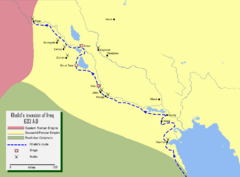
After the Ridda wars, a tribal chief named Al-Muthanna ibn Haritha raided Sasanian towns in Mesopotamia. He collected a lot of treasure. Al-Muthanna went to Medina to tell Abu Bakr about his success. Abu Bakr made him a commander. Al-Muthanna then raided deeper into Mesopotamia. He used his light cavalry to quickly attack towns near the desert and then disappear. This made Abu Bakr think about expanding the Rashidun Caliphate.
To win, Abu Bakr used a volunteer army. He put his best general, Khalid ibn al-Walid, in charge. Khalid had just defeated a false prophet. Abu Bakr ordered him to invade the Sasanian Empire. Khalid's goal was Al-Hirah. Abu Bakr sent more soldiers and told other tribal chiefs to join Khalid. Around March 633, Khalid left with 10,000 soldiers. The tribal chiefs joined him, making his army 18,000 strong.
After entering Mesopotamia, Khalid sent messages to all governors. He told them to become Muslim or pay a tax. He got no replies. Khalid then won four big battles:
- The Battle of Chains in April.
- The Battle of River in late April.
- The Battle of Walaja in May (where he used a clever double attack).
- The Battle of Ullais in mid-May.
The Persian court was already having problems. These defeats caused more chaos. In late May, the important city of Hira fell to the Muslims. After a rest, Khalid besieged al-Anbar in June, which surrendered in July. Khalid then moved south and conquered Ayn al-Tamr in late July. By this time, most of modern-day Iraq was under Muslim control.
Khalid then went to help another Muslim general in northern Arabia. He defeated rebels there. When he returned, he heard about a large Persian army gathering. He decided to defeat them in smaller groups. He attacked four Persian and Christian Arab armies at night. These were the Battle of Muzayyah, Battle of Saniyy, and Battle of Zumail in November. These defeats ended Persian control over Mesopotamia. The Persian capital Ctesiphon was now open to attack. Before attacking Ctesiphon, Khalid cleared out all Persian forces in the south and west. He marched to the border city of Firaz. There, he defeated the combined forces of the Sasanian Persians, Byzantines, and Christian Arabs in December. This was his last battle in Mesopotamia. Khalid was then ordered to go to Syria to fight the Romans.
Second Invasion (634–636)
Battle of the Bridge
Abu Bakr had wanted Umar to continue the conquest of Syria and Mesopotamia. In Mesopotamia, the situation was getting worse. When Khalid ibn al-Walid left Mesopotamia, the Persians tried to take back their land. The Muslim army had to pull back. Umar sent more soldiers to help Muthanna ibn Haritha. There were several battles, and the Arabs held their ground. But later, the Persians defeated Abu Ubaid in the Battle of the Bridge. Muthanna bin Haritha later won the Battle of Buwayb.
In 635, Yazdgerd III made an alliance with Emperor Heraclius of the Eastern Roman Empire. He married Heraclius's daughter to seal the deal. Heraclius prepared a big attack in Syria. Yazdegerd ordered large armies to push the Muslims out of Mesopotamia.

Battle of Qadisiyyah
Umar told his army to retreat to the Arabian border. He began gathering new armies in Medina for another campaign into Mesopotamia. Umar wanted to lead the army himself. But his advisors said he was needed in Medina for the two-front war. So, Umar appointed Saad ibn Abi Waqqas, an experienced officer, to lead. Saad left Medina in May 636 and arrived at Qadisiyyah in June.
Heraclius started his attack in May 636. But Yazdegerd couldn't get his armies ready in time to help the Byzantines. Umar knew about this alliance. He quickly sent more soldiers to the Yarmouk to defeat the Byzantines first. He also told Saad to try to make peace with Yazdegerd III. He invited Yazdegerd to become Muslim to stop the Persians from fighting. Heraclius told his general not to fight the Muslims without clear orders. But fearing more Arab soldiers, the general attacked in August 636 and was defeated.
With the Byzantine threat gone, the Sasanian Empire was still powerful. It had many soldiers, including war elephants. Within three months, Saad defeated the Persian army in the Battle of al-Qādisiyyah. This effectively ended Sasanian rule west of Persia. This victory was a turning point for Islam. With most Persian forces defeated, Saad and his companions conquered Babylon (Battle of Babylon (636)), Kūthā, Sābāṭ, and Bahurasīr. Ctesiphon, the Sasanian capital, fell in March 637 after a three-month siege.
Final Conquest (636–638)
In December 636, Umar ordered Utbah ibn Ghazwan to capture al-Ubulla and Basra. This would cut off the Persian soldiers there from Ctesiphon. Utbah arrived in April 637 and captured the region. The Persians pulled back, and the Muslims took that area too.
After Ctesiphon was conquered, Muslim groups were sent west. They captured Circesium and Heet, forts on the Byzantine border. Some Persian armies were still active northeast of Ctesiphon at Jalawla and north of the Tigris at Tikrit and Mosul.
The Persian armies gathered at Jalawla. This was an important place with routes to Mesopotamia, Khurasan, and Azerbaijan. Umar decided to deal with Jalawla first. This would clear the way north. Umar appointed Hashim ibn Utbah to take Jalawla. He sent Abdullah ibn Muta'am to conquer Tikrit and Mosul. In April 637, Hashim led 12,000 troops from Ctesiphon. They won a victory over the Persians at the Battle of Jalawla. He then besieged Jalawla for seven months until it was captured.
Abdullah ibn Muta'am then marched against Tikrit. He captured the city with the help of Christians after strong resistance. He then sent an army to Mosul. Mosul surrendered and agreed to pay a tax called Jizya. With victories at Jalawla and the capture of Tikrit-Mosul, all of Mesopotamia was under Muslim control.
A Muslim force then chased the escaping Persians to Khaniqeen. This city was 25 kilometers from Jalawla, on the road to Iran. The Persians were still led by Mihran. The Muslims defeated the Persian forces in the Battle of Khaniqeen and captured the city. The Persians then retreated to Hulwan. The Muslims followed and besieged the city, capturing it in January 638. The Muslim commander wanted to go deeper into Persia. But Umar refused, saying:
I wish that between the Suwad and the Persian hills there were walls which would prevent them from getting to us, and prevent us from getting to them. The fertile Suwad is sufficient for us; and I prefer the safety of the Muslims to the spoils of war.
Persian Raids in Mesopotamia (638–641)
By February 638, fighting on the Persian front slowed down. The Tigris and Euphrates valleys were fully under Muslim control. The Persians had retreated to Persia proper, east of the Zagros mountains. But they kept raiding Mesopotamia, which was still unstable. The Zagros mountains seemed to be the border.
In late 638, Hormuzan, a Persian chief, increased his raids in Mesopotamia. Saad, following Umar's orders, attacked Hormuzan. Another general attacked Ahvaz. Hormuzan was forced to sign a peace treaty. Ahvaz would remain his, but as a Muslim vassal state, and he would pay tribute. Hormuzan broke the treaty. Umar sent Abu Musa Ashaari, governor of Busra, to deal with him. After another defeat, Hormuzan signed another treaty. This peace also didn't last. Hormuzan got new Persian troops from Emperor Yazdgerd III in late 640. The troops gathered at Tuster. Umar sent several commanders there. Hormuzan was defeated, captured, and sent to Umar in Medina. Hormuzan became Muslim and helped Umar as an advisor. He is also thought to have planned Umar's assassination in 644.
After the victory at Tustar, Abu Musa marched against the important city of Susa in January 641. He captured it after a siege. Next, Abu Musa marched against Junde Sabur. This was the last important military place in the Persian province of Khuzistan. It surrendered to the Muslims after a few weeks.
Battle of Nahavand (642)
After conquering Khuzistan, Umar wanted peace. The Persian Empire was weaker, but Arabs still saw it as a powerful force. Umar was careful about fighting it more. He preferred to leave the rest of the Persian Empire alone. He said, "I wish there was a mountain of fire between us and the Persians, so that neither they could get to us, nor we to them."
But Persian pride was hurt by the Arab conquest. They couldn't accept the situation. After the defeat at the Battle of Jalula in 637, Yazdgerd III went to Rey. From there, he moved to Merv. He made Merv his capital and told his chiefs to keep raiding Mesopotamia. Within four years, Yazdgerd III felt strong enough to challenge the Muslims again. He gathered 100,000 experienced soldiers and volunteers from all over Persia. This army, led by Mardan Shah, marched to Nahavand for the final big battle.
The Governor of Kufa, Ammar ibn Yasir, learned about the Persian army at Nahavand. He reported it to Umar. Umar had wanted Mesopotamia to be his eastern border. But the large Persian army at Nahavand forced him to act. He now believed that as long as Persia was under Sasanian rule, raids into Mesopotamia would continue.
Hudheifa ibn Al Yaman was made commander of the Kufa forces. He was ordered to march to Nahavand. Abu Musa was to march from Busra. Nouman ibn Muqarrin marched from Ctesiphon. Umar decided to lead the army from Medina himself. But his advisors suggested he command from Medina and appoint a good field commander for Nahavand. Umar agreed. He appointed Mugheera ibn Shuba to lead the Medina forces. Nouman ibn Muqarrin became the commander-in-chief at Nahavand. The Muslim army gathered at Tazar. They then defeated the Persians at the Battle of Nahavand in December 642. Nouman died in the battle. Hudheifa ibn Al Yaman became the new commander. After this, the Muslims captured the whole district of Hamadan with little resistance.
Conquest of Persia (642–651)
After several years, Caliph Umar decided on a new plan. He prepared a full invasion of the remaining Sasanian Empire. The Battle of Nahavand was very important in Islamic history. It opened the way to Persia. After the big defeat at Nahavand, the last Sasanian emperor, Yazdegerd III, fled. He tried to raise a new army in different parts of Persia, but with little success. Umar tried to capture him.
Strategic Planning
Umar decided to attack the Persians right after their defeat at Nahavand. He still had a psychological advantage. Umar had to choose which of three provinces to conquer first: Fars in the south, Azerbaijan in the north, or Isfahan in the center. Umar chose Isfahan. It was the heart of the Persian Empire. It was also a key link for supplies and communication. Capturing it would cut off Fars and Azerbaijan from Khorasan, where Yazdegerd was strong. After taking Fars and Isfahan, attacks would be launched at the same time against Azerbaijan and Sistan. These were the northwest and easternmost provinces. Conquering them would leave Khorasan isolated. This would be the last step in conquering Sasanian Persia.
Preparations were ready by January 642. The plan's success depended on Umar's ability to coordinate attacks from Medina, 1500 kilometers away. It also depended on his commanders' skills. Umar used a different command structure. Instead of one commander for the whole campaign, he appointed several. Each had a different mission. Once a commander's mission ended, he would become a regular soldier under the next commander. This was to remind commanders that they were like everyone else. Command was given only to the most skilled, and then they returned to their previous role.
Before the campaign, Umar wanted to boost morale. He decided to put Khalid back as a field commander. Khalid had been dismissed four years earlier. Khalid's reputation as a conqueror of Roman lands scared the Persian commanders. Most of them had already been defeated by him in Mesopotamia in 633. But before Umar could give the order, Khalid died.
Throughout the Persian campaign, Umar even appointed commanders for different parts of the army. Umar told his commanders to ask him before making any big moves in Persia. All commanders had to send detailed reports. These reports included maps of the area, and positions of Persian forts, cities, and troops. Umar would then send a detailed plan for how to capture the region. Only small tactical decisions were left to the field commanders. Umar chose the best and most respected commanders for the campaign.
Conquest of Central Iran

After Khalid's death, Umar appointed Abdullah ibn Uthman to lead the invasion of Isfahan. From Nahavand, Nu'man ibn Muqaarin marched to Hamadan. Then he went 370 kilometers southeast to Isfahan. He defeated a Sasanian army there. The Sasanian commander, Shahrvaraz Jadhuyih, was killed. Nu'man, with new troops, then besieged the city. The siege lasted a few months before the city surrendered.
In 651, Nu'aym ibn Muqaarin, Nu'man's brother, marched northeast to Rey, Iran. This was about 320 kilometers from Hamadan. He besieged the city, which surrendered after strong resistance. Nu'aym then marched 240 kilometers northeast to Qom. This city was captured easily. This marked the border of the Isfahan region. Further northeast was Khurasan, and southeast was Sistan. Meanwhile, Hamadan and Rey had rebelled. Umar sent Nu'aym to Hamadan to stop the rebellion. Nu'aym recaptured Hamadan after a bloody battle. He then went to Rey. The Persians resisted there too but were defeated. The Muslims recaptured the city. The Persian citizens asked for peace and agreed to pay the Jizya tax. From Rey, Nu'aym moved north to Tabaristan, south of the Caspian Sea. The ruler of Tabaristan then signed a peace treaty with the Caliphate.
Conquest of Fars
First Invasion and Persian Counter-attack
The Muslim invasion of Fars began in 638/9. The Muslim governor of Bahrain, al-'Ala' ibn al-Hadrami, had defeated some rebellious Arab tribes. He then took an island in the Persian Gulf. He and his men were told not to invade Fars. But they continued their raids. Al-'Ala quickly prepared an army and divided it into three groups.
When the first group entered Fars, it was quickly defeated. The same happened to the second group. The third group held off the defenders. But they were blocked from going back to Bahrain by the Sasanians. Umar found out about al-'Ala's invasion. He replaced him with Sa'd ibn Abi Waqqas as governor. Umar then ordered more soldiers to help the third group. Once help arrived, some of the men managed to go back to Bahrain. The rest went to Basra.
Second and Final Invasion
Around 643, Uthman ibn Abi al-As captured Bishapur, which signed a peace treaty. In 644, al-'Ala' again attacked Fars from Bahrain. He reached Estakhr. But he was pushed back by the Persian governor, Shahrag. Later, Uthman ibn Abi al-As set up a military base. He soon defeated and killed Shahrag. A Persian who had become Muslim was sent to attack a fortress on the coast of Fars.
After Uthman ibn Affan became the new Rashidun Caliph in November, the people of Bishapur rebelled. They were led by Shahrag's brother. But they were defeated. This happened in 646.
In 648, 'Abd-Allah ibn al-'Ash'ari forced the governor of Estakhr to surrender the city. Its citizens rebelled in 649/650. The military governor of Estakhr was defeated and killed. In 650/651, Yazdegerd went there to plan resistance. Estakhr resisted weakly and was soon destroyed by the Arabs. Over 40,000 defenders were killed. The Arabs then quickly took other cities. Yazdegerd fled to Kerman. Muslim control of Fars was shaky for a while. Several local rebellions followed the conquest.
Conquest of Southeastern Persia (Kerman and Makran)
The expedition to Kerman, led by Suhail ibn Adi, was sent around the same time as those to Sistan and Azerbaijan. Suhail marched from Busra in 643. He passed through Shiraz and Persepolis. He joined other armies and then marched against Kerman. Kerman was conquered after a big battle with local soldiers.
Conquest of Sakastan

The Arabs had been raiding Sakastan since Umar's time. The first real invasion was in 650. Abd-Allah ibn Amir, after securing Kerman, sent an army under Mujashi ibn Mas'ud there. After crossing the desert, Mujashi ibn Mas'ud reached Sakastan. But he suffered a heavy defeat and had to retreat.
One year later, Abd-Allah ibn Amir sent another army under Rabi ibn Ziyad Harithi to Sakastan. Rabi reached a border town and forced its leader to accept Muslim rule. He did the same at a fortress. He then took more land. Next, he besieged the capital city, Zrang. After a heavy battle, its governor, Aparviz, surrendered. Aparviz negotiated a treaty to save the people of Sakastan. He agreed to pay a large tribute of 1 million dirhams, including 1,000 slave boys or girls with golden vessels. Rabi ibn Ziyad was then made governor.
Eighteen months later, Rabi was called back. He was replaced by 'Abd al-Rahman ibn Samura. The people of Sakastan used this chance to rebel. They defeated the Muslim soldiers at Zrang. When 'Abd al-Rahman ibn Samura arrived, he stopped the rebellion. He also defeated the Zunbils and took some cities.
Conquest of Iranian Azerbaijan
The conquest of Iranian Azerbaijan began in 651. This was part of attacks on Kerman, Makran, Sistan, and Azerbaijan. Hudheifa ibn Al Yaman was sent to Azerbaijan. He marched from Rey to Zanjan, a strong Persian fort. The Persians came out to fight. Hudheifa defeated them and captured the city. Those who wanted peace were given it if they paid the jizya tax.
From Zanjan, Hudheifa marched to Ardabil, which surrendered peacefully. Hudheifa continued north along the western coast of the Caspian Sea. He captured Bab al-Abwab by force. At this point, Hudheifa was called back. He was replaced by Bukair ibn Abdullah and Utba ibn Farqad. They were sent to attack Azerbaijan from two sides. Bukair went along the western Caspian coast. Uthba went into the heart of Azerbaijan.
On his way north, Bukair was stopped by a large Persian force. It was led by Isfandiyar, son of Farrukhzad. A fierce battle was fought. Isfandiyar was defeated and captured. To save his life, he agreed to give up his lands in Azerbaijan. He also agreed to convince others to accept Muslim rule. Uthba ibn Farqad then defeated Bahram, Isfandiyar's brother. He also asked for peace. Azerbaijan then surrendered to Caliph Umar. They agreed to pay the annual jizya tax.
Conquest of Armenia
The Muslims had conquered Byzantine Armenia in 638–639. Armenia remained in Persian hands, along with Khurasan. Umar didn't take any chances. He didn't think the Persians were weak. This helped the quick conquest of the Persian Empire. Umar again sent armies at the same time to the far northeast and northwest of the Persian Empire. One went to Khurasan in late 643. The other went to Armenia.
Bukair ibn Abdullah was ordered to capture Tiflis. From Bab, on the western coast of the Caspian Sea, Bukair continued north. Umar used his usual successful strategy of attacking from multiple sides. While Bukair was still far from Tiflis, Umar told him to divide his army into three groups. Umar appointed Habib ibn Muslaima to capture Tiflis. Abdulrehman was to march north into the mountains. Hudheifa was to march against the southern mountains. All three missions succeeded. The advance into Armenia ended when Umar died in November 644. By then, almost all of the South Caucasus was captured.
Conquest of Khorasan
Khorasan was the second-largest province of the Sasanian Empire. It covered parts of modern-day northeastern Iran, northwestern Afghanistan, and southern Turkmenistan. In 651, the conquest of Khurasan was given to Ahnaf ibn Qais. Ahnaf marched from Kufa. He took a shorter, less used route through Rey and Nishapur. Rey was already under Muslim control. Nishapur surrendered without a fight.
From Nishapur, Ahnaf marched to Herat in western Afghanistan. Herat was a fortified town. The siege lasted a few months before it surrendered. This brought all of southern Khorasan under Muslim control. Ahnaf then marched north to Merv, in modern-day Turkmenistan. Merv was the capital of Khurasan. Yazdegred III held his court there. Hearing of the Muslim advance, Yazdegerd III left for Balkh. Merv offered no resistance, and the Muslims took the capital without a fight.
Ahnaf stayed at Merv and waited for more soldiers from Kufa. Meanwhile, Yazdegerd had gathered a strong army at Balkh. He allied with the Turkic Khan of Farghana, who brought his own soldiers. Umar ordered Ahnaf to break up this alliance. The Khan of Farghana realized that fighting the Muslims might put his own kingdom in danger. So, he left the alliance and went back to Farghana. The rest of Yazdegerd's army was defeated at the Battle of Oxus River. They retreated across the Oxus to Transoxiana. Yazdegerd himself barely escaped to China. The Muslims had now reached the very edge of Persia. Beyond that were the lands of the Turks and then China. Ahnaf returned to Merv. He sent a detailed report of his success to Umar. He asked for permission to cross the Oxus river and invade Transoxiana. Umar ordered Ahnaf to stop and instead strengthen his control south of the Oxus.
Persian Rebellion and Reconquest
Umar was assassinated in November 644 by a Persian slave named Abu Lu'lu'a Firuz. Umar had refused to remove a tax on him. Soon after, Abu Lu'lu'a was killed. In revenge, Ubayd Allah ibn Umar (one of Umar's sons) killed Abu Lu'lu'a's daughter. He also said he would kill all non-Arabs in Medina. Ubayd Allah killed Hurmuzān, a former Sasanian military officer. Hurmuzān had been an advisor to Umar after being captured. Ubayd Allah also killed Jufayna, a Christian man. These killings show the strong tensions between Arabs and non-Arabs in the early Islamic caliphate.
Uthman ibn Affan (644–656) became caliph after Umar. During his rule, almost all of the former Sasanian empire rebelled at different times. He had to send many armies to stop the rebellions. The main rebellions were in Armenia, Azerbaijan, Fars, Sistan (in 649), Khorasan (651), and Makran (650). Finally, in 651, Yazdegerd III, the last Sasanian emperor, was killed near Merv. He was killed by a local miller for his money. This ended his dynasty and organized Persian resistance. Meanwhile, Uthman's empire grew beyond the Sasanian Empire's borders. It expanded into Transoxiana, Baluchistan, and the Caucasus. For many decades, this was the easternmost limit of Muslim rule.
Persia Under Muslim Rule
According to historian Bernard Lewis:
Arab Muslims conquests have been variously seen in Iran: by some as a blessing, the advent of the true faith, the end of the age of ignorance and heathenism; by others as a humiliating national defeat, the conquest and subjugation of the country by foreign invaders. Both perceptions are of course valid, depending on one's angle of vision... Iran was indeed Islamized, but it was not Arabized. Persians remained Persians. And after an interval of silence, Iran reemerged as a separate, different and distinctive element within Islam, eventually adding a new element even to Islam itself. Culturally, politically, and most remarkable of all even religiously, the Iranian contribution to this new Islamic civilization is of immense importance. The work of Iranians can be seen in every field of cultural endeavor, including Arabic poetry, to which poets of Iranian origin composing their poems in Arabic made a very significant contribution. In a sense, Iranian Islam is a second advent of Islam itself, a new Islam sometimes referred to as Islam-i Ajam. It was this Persian Islam, rather than the original Arab Islam, that was brought to new areas and new peoples: to the Turks, first in Central Asia and then in the Middle East in the country which came to be called Turkey, and of course to India. The Ottoman Turks brought a form of Iranian civilization to the walls of Vienna.
Administration

Under Umar and the rulers who came right after him, the Arab conquerors tried to keep their own culture. They didn't want to mix too much with the people they conquered. The Arabs first settled in special military towns. They did not spread out onto scattered farms.
New non-Muslim subjects were protected by the state. They were called dhimmi (meaning 'protected'). They had to pay a special tax called jizya (meaning 'tribute'). This tax was usually two dirhams for able-bodied men of military age. In return, they did not have to serve in the military. Women and children were free from this tax.
Large-scale conversions to Islam were not wanted or allowed at first. Umar reportedly gave instructions about protected people: "Make it easy for him, who can not pay tribute; help him who is weak, let them keep their titles, but do not give them our kuniyat [Arabic traditional nicknames or titles]." Umar's kind policies continued under his successors. He reportedly told Uthman to "be kind to the dhimmis, to keep their covenant, to protect them and not to burden them over their strength."
The jizya tax replaced the older Sasanian poll taxes. These old taxes were often much higher than the jizya. In addition to the jizya, the old Sasanian land tax (called Kharaj in Arabic) was also kept. Umar sometimes set up groups to check tax burdens. This was to make sure the taxes were not more than the land could produce. It is said that Zoroastrians faced insults when paying the jizya. This was meant to make them feel less important.
The administrative system of the late Sasanian period was mostly kept. The state was divided into provinces, then districts, then sub-districts. Provinces were called ustan. Districts were called shahrs, with a capital city called a shahristan. Sub-districts were called tasok, which became tassuj in Arabic.
Religion
Zoroastrians had to pay an extra tax called jizya. If they didn't, they could be killed, enslaved, or imprisoned. Those who paid jizya were sometimes insulted by tax collectors. Zoroastrians captured as slaves in wars were freed if they became Muslim. While people had a choice, those who converted to Islam received special benefits. The conversion process was slow and took many centuries. A majority of Persians still followed Zoroastrianism even a thousand years later.
Muslim leaders encouraged people to attend Muslim prayers. They promised money to those who converted. They also allowed the Quran to be read in Persian instead of Arabic. This made it understandable to everyone. Islam was easily accepted by Zoroastrians who worked in factories or as artisans. This was because their religion said such jobs made them impure. Also, Muslim missionaries found it easy to explain Islam to Zoroastrians. There were many similarities between the two faiths. For example, the Persian gods Ahura Mazda and Ahriman could be compared to Allah and Iblis. In Afghanistan, Islam spread due to Muslim missionary efforts.
There were also large and thriving Christian and Jewish communities. Smaller numbers of Buddhists and other groups also lived there. The population slowly but steadily moved towards Islam. The rich and city dwellers converted first. Islam spread more slowly among farmers and landowners. By the late 10th century, most Persians had become Muslim.
Until the 15th century, most Persian Muslims were Sunni Muslims. But with the rise of the Safavids in the early 16th century, they forced Sunnis to convert. This led to the rise of the Shi'a Muslim faith in Iran.
Language of Persia
During the Rashidun Caliphate, the official language of Persia (including Mesopotamia) remained Middle Persian (Pahlavi). This was like how Greek and Coptic remained official languages in Syria and Egypt. During the Umayyad Caliphate, the Umayyads made Arabic the main language for all their conquered people. This replaced their local languages. For example, Al-Hajjaj ibn Yusuf (661–714) officially changed the administrative language of Iraq from Middle Persian to Arabic.
Today, an area from Iraq to Morocco speaks Arabic-based dialects. But Middle Persian lasted much longer. Most of its structure and words survived. It developed into New Persian. Persian took some Arabic words, especially religious ones. It also changed from the Pahlavi scripts to a modified version of the Arabic alphabet. Today, Persian is an official language in Iran, Afghanistan, and Tajikistan.
Urbanisation
The Arab conquest of Persia led to a time of huge city growth in Iran. This started with the rise of the Abbasid dynasty and ended in the 11th century CE. This was especially true for the eastern parts of the country. Regions like Khorasan and Transoxiana saw many large cities develop. Some cities grew to have populations of up to 200,000 people.
This period of rapid city growth was followed by an economic collapse in the late 11th and early 12th centuries. This led to many Iranians moving to Central Asia, India, the rest of the Middle East, and Anatolia. Some say this disaster is why the Persian language became common in Central Asia and large parts of the Middle East.
Images for kids
-
Coin of the Rashidun Caliphate. Imitation of Sasanid Empire ruler Khosrau II type. BYS (Bishapur) mint. Dated YE 25 = AH 36 (AD 656). Sasanian style bust imitating Khosrau II right; bismillah in margin/ Fire altar with ribbons and attendants; star and crescent flanking flames; date to left, mint name to right.
See also
 In Spanish: Conquista musulmana de Persia para niños
In Spanish: Conquista musulmana de Persia para niños
- Arab-Persians
- Arab-Byzantine Wars
- Arab rule in Georgia
- Emirate of Tbilisi
- History of Arabs in Afghanistan
- History of Iran
- Xwedodah, Consanguine marriage
- Islam in Iran
- Islamic conquest of Afghanistan
- Islamization of Iran
- Military history of Iran
- Muslim conquests
- Safavid conversion of Iran to Shia Islam
- Muslim conquest of Transoxiana
- Spread of Islam
- History of Iran after Islam
- Iran during the Caliphate


